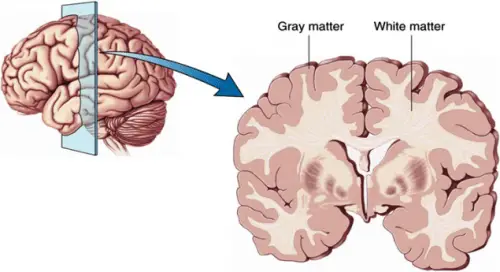The central nervous system (CNS) is made up of two types of tissue: white and gray matter. While they may bear strong associations, their differences go beyond what meets the eye.
Summary Table
| White Matter | Gray Matter |
| Made up of bundles of myelinated axons | Made up of neutrophils, glial cells, neuronal cell bodies, capillaries, synapses, and a few myelinated axons |
| Color: white | Color: pinkish gray |
| Mostly located in the superficial areas of the spinal cord and in the internal areas of the brain | Mostly located in the internal areas of the spinal cord and on the superficial areas of the brain |
| Fully develops once a person reaches middle age | Fully develops once a person reaches his/her twenties |
| Makes up 60% of the brain | Makes up 40% of the brain |
| Responsible for learning and cognition | Responsible for sensory perception, muscle control, self-control, decision-making, memory, and data processing |
Definitions

White matter pertains to the area of the brain and the spinal cord that is mainly comprised of bundles of myelinated axons, also known as tracts. It plays a critical role in conducting, processing, and transmitting nerve signals between the different regions of the brain.
Meanwhile, gray matter is made up of neutrophils, glial cells, neuronal cell bodies, capillaries, and synapses. Found in the brainstem, the cerebrum, and the cerebellum, gray matter is one of the main components of the central nervous system.
White vs Gray Matter
Aside from their color, there is a huge difference between white and gray matter.
Components
White matter is mainly comprised of bundles of myelinated axons, also known as tracts. Myelin is rich in lipids and protein, and it mainly functions to protect axons and convey nerve signals.
Unlike white matter, gray matter contains few myelinated axons. An integral part of the CNS, gray matter is made up of neutrophils, glial cells, neuronal cell bodies, capillaries, and synapses.
Color
The most noticeable difference between the white and the gray matter is their color. The myelin sheets present in the white matter greatly attribute to its white color, while the neuronal cell bodies and the capillaries in the gray matter are responsible for its pinkish gray color.
Location
Aside from filling in the deep sections of the brain, white matter is also abundant in the superficial areas of the spinal cord. Gray matter, on the other hand, is located deep within the cerebrum, along with superficial areas in the cerebellum and the cerebral hemisphere. Additionally, gray matter is also present in parts of the spinal cord, where it is referred to as the gray column, a structure that greatly resembles letter H.
Simply put, the depth of the positioning of gray and white matter greatly depends on the structure. In the spinal cord, white matter is located in the superficial areas, while gray matter is found deeper in the structure. In most parts of the brain, however, this is reversed.
Development
Gray matter becomes fully developed as a person matures and reaches his/her twenties, while white matter continues to grow and develop until a person reaches middle age.
Percentage
White matter makes up 60% of the brain, whereas gray matter accounts for the remaining percentage.
Function
Since it aids in processing and transmitting nerve signals between the different regions of the brain, white matter is mainly responsible for learning and cognition. Gray matter, by comparison, occupies parts of the brain involved in sensory perception, muscle control, self-control, decision-making, memory, and data processing.
Other Differences Between White Matter and Gray Matter
Gray and white matter are crucial parts of the brain and spinal cord. About 40% of the brain is gray matter and 60% consists of white matter.
Most of the brain’s processing power happens in gray matter. That’s because the neuronal cell bodies and their associated dendrites (short, fingerlike protrusions) communicate with herby neurons.
On the other hand, white matter is made of long axons of neurons. These transmit impulses to the more distant areas of the brain and spinal cord. White matter processes sensation, perception, voluntary movement, learning, speech, and cognition. White matter also provides communication between different gray matter areas and between the gray matter and the body.
Diseases of the White Matter and Grey Matter
Certain diseases can affect the white matter and the gray matter.
Gray Matter Disease
Gray matter can atrophy over time when nerve cells die. One of the most common causes of this problem is the lack of blood flow to the cells in these regions of the brain.
Lack of blood flow can be caused by stroke, brain hemorrhage, damage, and more. Other conditions include:
Alzheimer’s disease
Parkinson’s disease
MS (Multiple sclerosis)
Traumatic brain injury
White Matter Disease
Different conditions can also damage the white matter of the brain. When this happens, it can cause issues with thinking, problem-solving, balance, and more.
White matter disease can be caused by stroke, cerebral adrenoleukodystrophy, and MS (multiple sclerosis). The disease is progressive, but the symptoms may be mild in the beginning. As the disease progresses, the symptoms tend to worsen.





